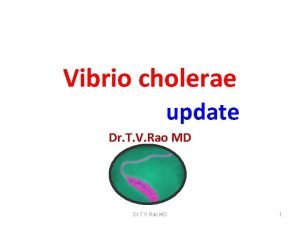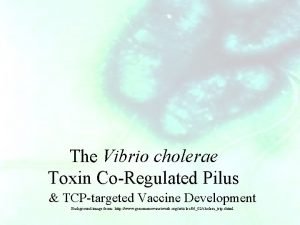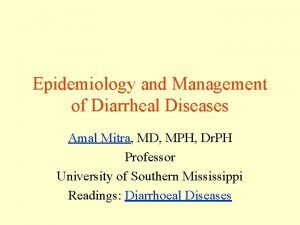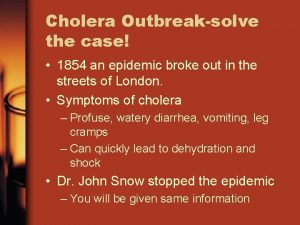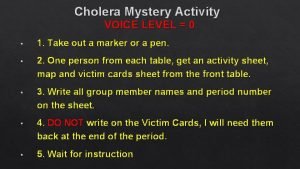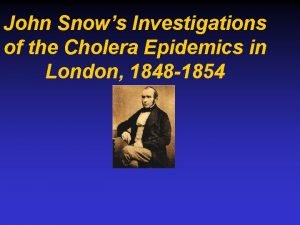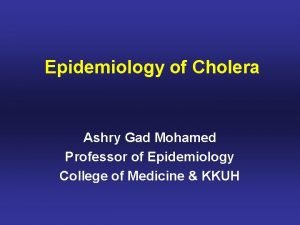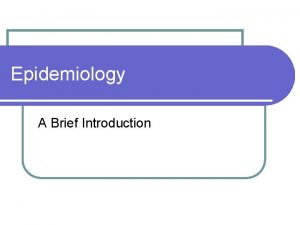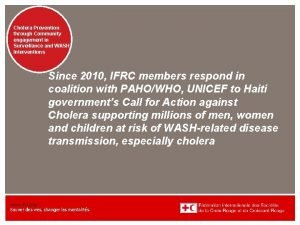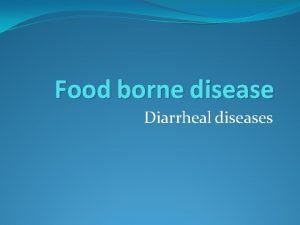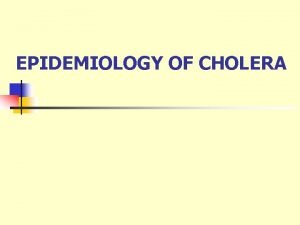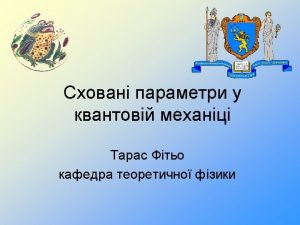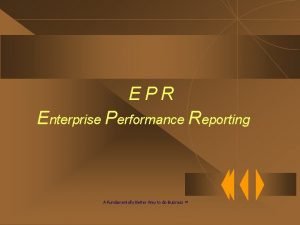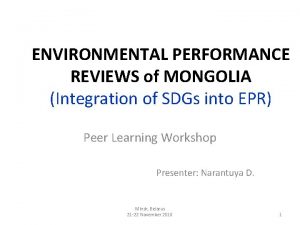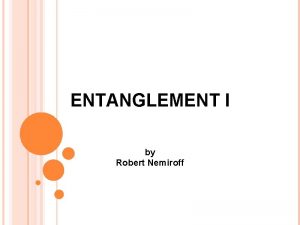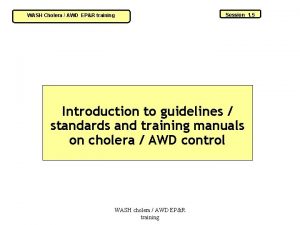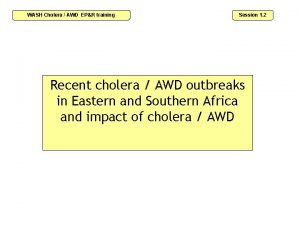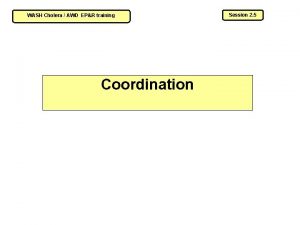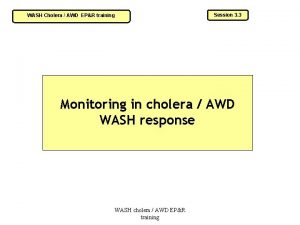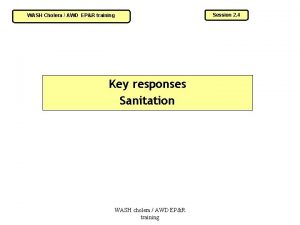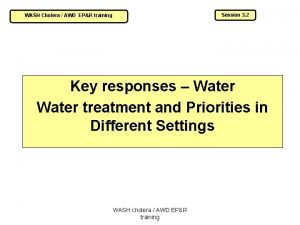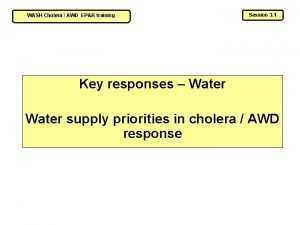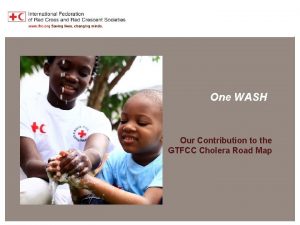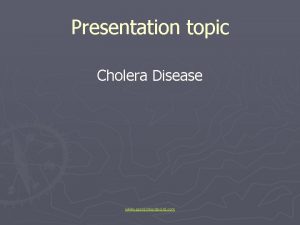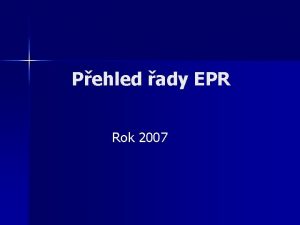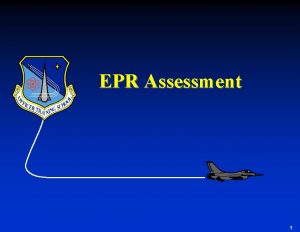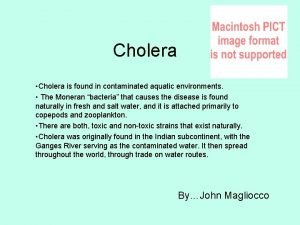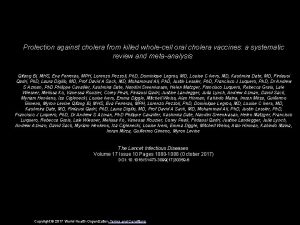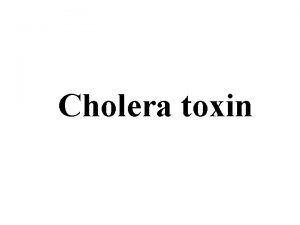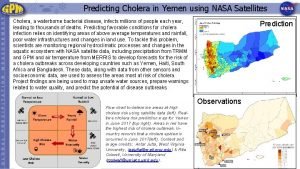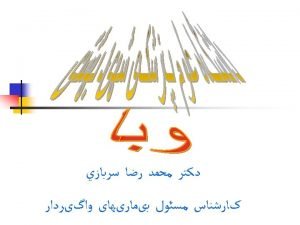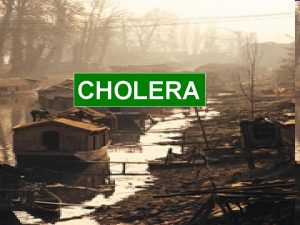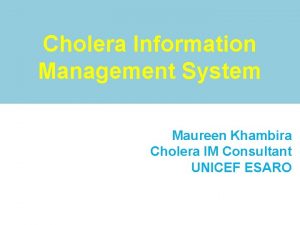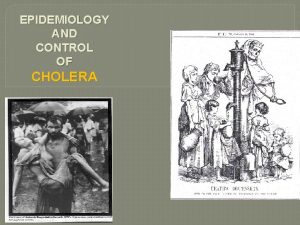WASH Cholera AWD EPR training Disease surveillance compilation


























- Slides: 26

WASH Cholera / AWD EP&R training Disease surveillance, compilation and analysis of basic epidemiological data (from the WASH point of view) Session 1. 4

Learning objectives By the end of the session the participants will be able to • define surveillance • understand why early reporting and rapid response is critical in cholera outbreaks • analyse cholera outbreak characteristics according to environment • be familiar with basic epidemiological measures • describe how to apply surveillance data to guide WASH intervention WASH cholera / AWD EP&R training 2

Surveillance …is the ongoing systematic collection, collation, analysis and interpretation of data; and the dissemination of information to those who need to know in order that action may be taken WASH cholera / AWD EP&R training 3

Passive surveillance System draws data from existing health facilities reporting Active surveillance Purposeful effort to collect data e. g. community survey and case investigation and follow up WASH cholera / AWD EP&R training 4

Work in pairs With your pair discuss following: What could be your role as a WASH practitioner in Passive surveillance? What could be your role as a WASH practitioner in Active surveillance? 5 min – feedback in plenary WASH cholera / AWD EP&R training 5

Work in pairs continues With your pair discuss the following: What could be the role of the community in Passive surveillance? What could be the role of the community in Active surveillance? 5 min – feedback in plenary WASH cholera / AWD EP&R training 6

What to avoid – Data collected but not used WASH cholera / AWD EP&R training 7

Epidemiological Surveillance Characterise cases and deaths by: age, sex, locality, occupation etc Present data in form of graphs: linear, bar graph or histograms and disease spot maps. Calculate important indicators such as: - Attack rates Age specific Sex specific Area specific - Case fatality rates - Population at risk Weekly reporting of cases and deaths using weekly epidemic monitoring form. WASH cholera / AWD EP&R training 8

WASH cholera / AWD EP&R training 9

WASH cholera / AWD EP&R training 10

Organising data by time WASH cholera / AWD EP&R training 11

Organising data by place MSF Cholera Guidelines 2004 WASH cholera / AWD EP&R training 12

WASH cholera / AWD EP&R training 13

WASH cholera / AWD EP&R training 14

MAJOR CHOLERA OUTBREAK CHARACTERISTICS ACCORDING TO ENVIRONMENT- SOURCE MFS CHOLERA GUIDELINES 2004 OPEN SITUATION, RURAL, LARGE SCALE URBAN SETTING, SLUM CLOSED SITUATION, REFUGEE CAMP LOW HIGH TO VERY HIGH POPULATION SIZE HIGH SMALL POPULATION DENSITY POPULATION MOBILITY MOBILE, SCATTERED MOBILE NOT VERY MOBILE PEAK REACHED 1. 5 TO 3 MONTHS 1 -2 MONTHS 2 -4 WEEKS PROPOTION OF CASES SEEN BEFORE THE PEAK 40% 40% EPIDEMIC DURATION 3 -6 MONTHS 2 -4 MONTHS 1 -3 MONTHS WASH cholera / AWD EP&R training 15

In densely populated environments i. e. refugee camp (closed situation) or slums, when adequate response is provided, the epidemic is characterized by a high attack rate, a short duration of outbreak, a rapid peaking and a low case fatality rate. In open situations i. e. rural areas, epidemic patterns are: low attack rate, Longer duration of outbreak, later appearance of peak and higher CFR. WASH cholera / AWD EP&R training 16

An important epidemiological measure. . Case Fatality Rate Proportion of cases that resulted in death Number of deaths from cholera X 100 Number of cases of cholera WASH cholera / AWD EP&R training 17

MAJOR CHOLERA OUTBREAK CHARACTERISTICS ACCORDING TO ENVIRONMENT- SOURCE MFS CHOLERA GUIDELINES 2004 OPEN SITUATION, RURAL, LARGE SCALE URBAN SETTING, SLUM CLOSED SITUATION, REFUGEE CAMP POPULATION DENSITY LOW HIGH TO VERY HIGH POPULATION SIZE HIGH SMALL POPULATION MOBILITY MOBILE, SCATTERED MOBILE NOT VERY MOBILE PEAK REACHED 1. 5 TO 3 MONTHS 1 -2 MONTHS 2 -4 WEEKS PROPOTION OF CASES SEEN BEFORE THE PEAK 40% 40% EPIDEMIC DURATION 3 -6 MONTHS 2 -4 MONTHS 1 -3 MONTHS CFR <5% 2– 5% <2% WASH cholera / AWD EP&R training 18

So what does CFR tell to us… CFR of greater than 1% is generally considered to be high but in rural areas with poor access to health care and early rehydration CFR can be higher In closed situations and in slums CFR is low because of access to medical care and rehydration is quicker CFR is high in the beginning of the outbreak due to time relapse in setting up adequate response CRF can also be high in the end of the epidemic due to staff exhaustion at the cholera management facilities Investigate are there any underlying causes contributing to high CFR such as malnutrition CFR is an indicator of adequate case management and timely access to health care WASH cholera / AWD EP&R training 19

Group work With your group discuss the following: A cholera outbreak has been declared in a community. You are working in the same community implementing a WASH programme. You get reports from the local cholera management facility that CFR is high. What actions could you take in your WASH programme that may assist in bringing down the CFR ? 10 min for group work – record your discussion points WASH cholera / AWD EP&R training 20

Another important epidemiological measure. . Attack rate Number of cholera cases among the population at risk Number of cases of cholera X 100 Population at risk WASH cholera / AWD EP&R training 21

MAJOR CHOLERA OUTBREAK CHARACTERISTICS ACCORDING TO ENVIRONMENT- SOURCE MFS CHOLERA GUIDELINES 2004 OPEN SITUATION, RURAL, LARGE SCALE URBAN SETTING, SLUM CLOSED SITUATION, REFUGEE CAMP POPULATION DENSITY LOW HIGH TO VERY HIGH POPULATION SIZE HIGH SMALL POPULATION MOBILITY MOBILE, SCATTERED MOBILE NOT VERY MOBILE PEAK REACHED 1. 5 TO 3 MONTHS 1 -2 MONTHS 2 -4 WEEKS PROPOTION OF CASES SEEN BEFORE THE PEAK 40% 40% EPIDEMIC DURATION 3 -6 MONTHS 2 -4 MONTHS 1 -3 MONTHS CFR <5% 2– 5% <2% ATTACK RATE 0. 1 TO 2 % 1 TO 5 % WASH cholera / AWD EP&R training 22

So what does the AR tell to us… AR is higher in a closed situation or in slums because of high population density Calculation of AR assist in estimation of supplies needed (prediction of how many people might become ill) AR directs you in investigation of e. g. hot spot areas, population groups most affected etc. WASH cholera / AWD EP&R training 23

Calculation exercise in plenary An epidemic of suspected cholera has just begun in three districts of Liu Province. • Capital district reported 1600 cases, and 40 deaths. The total population is 150, 000 persons. Provincial hospital is located in the main town. • Remote district reported 200 cases (first reported case was from here) and 25 deaths. The total population is 50, 000 persons • Market district reported 200 cases and 10 deaths. The total population is 100, 000. Calculate CFR per district Calculate AR per district WASH cholera / AWD EP&R training 24

Population Cases Deaths CFR AR Capital district 150, 000 1, 600 40 40/1600 = 0. 25 x 100 = 2. 5 CFR=2. 5% 1, 600/ 150, 000 = 0. 0106 x 100=1. 06 AR=1. 1% Remote district 50, 000 25 25/200 = 0. 175 x 100 =17. 5 CFR=17. 5% 200/50, 000= 0. 004 x 100= 0. 4 AR=0. 4% Market district 100, 000 200 10 10/200 = 0. 05 x 100 = 5 CFR=5% 200/100, 000 =0. 002 x 100= 0. 2 AR=0. 2% WASH cholera / AWD EP&R training 25

Learning objectives By the end of the session the participants will be able to • define surveillance • understand why early reporting and rapid response is critical in cholera outbreaks • analyse cholera outbreak characteristics according to environment • be familiar with basic epidemiological measures • describe how to apply surveillance data to guide WASH intervention WASH cholera / AWD EP&R training 26
 Vibrio cholerae stool microscopy
Vibrio cholerae stool microscopy Cholera classification
Cholera classification Types of cholera
Types of cholera Cholera toxin
Cholera toxin Cholera
Cholera Solve the baltimore cholera mystery puzzle
Solve the baltimore cholera mystery puzzle Cholera outbreak malaysia
Cholera outbreak malaysia Cholera
Cholera Epidemiological triad of typhoid fever
Epidemiological triad of typhoid fever Epornithic
Epornithic Cholera
Cholera Cholera
Cholera Diarrhea plan a
Diarrhea plan a Cholera is a greek word that means gutter of roof
Cholera is a greek word that means gutter of roof Stan singletowy
Stan singletowy Epr effect
Epr effect Epr example
Epr example Epr bullets self improvement
Epr bullets self improvement Sue jennings epr
Sue jennings epr Epr cms
Epr cms Epr einstein podolsky rosen
Epr einstein podolsky rosen Epr enterprise
Epr enterprise Epr paradox
Epr paradox Epr.ulaanbaatar
Epr.ulaanbaatar Epr paradox
Epr paradox Sylvie richard edf
Sylvie richard edf Bharathi viswanathan
Bharathi viswanathan
